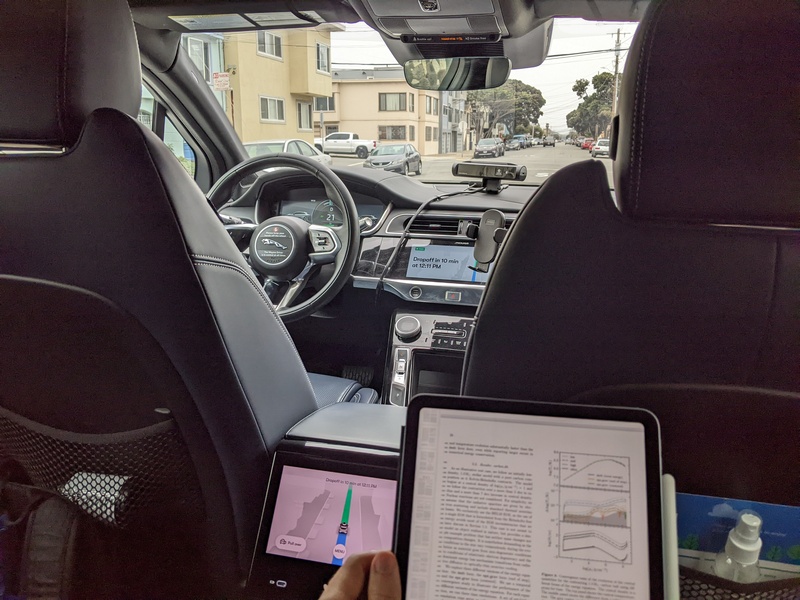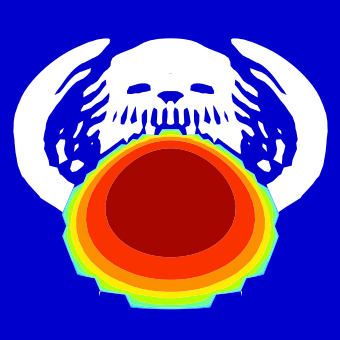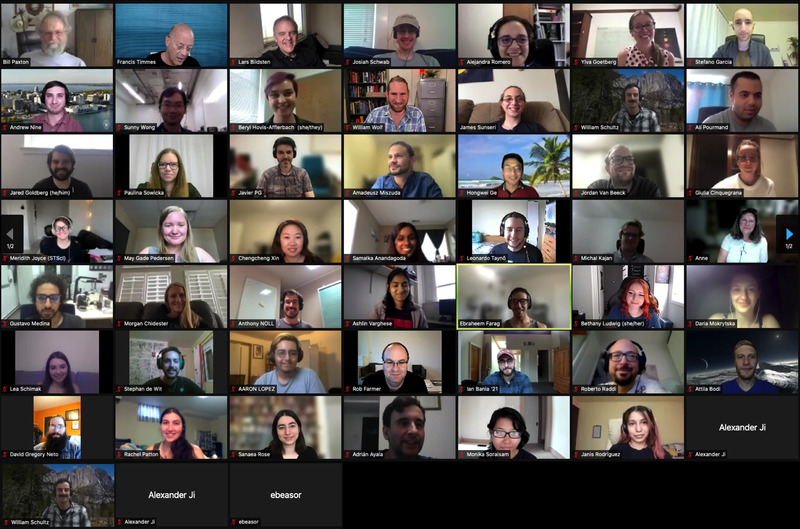26 Jul 2022
I took my first fully autonomous Waymo ride in San Francisco! Watching the empty car pull up and then being alone inside was an amazing feeling. The peace and quiet gave me a chance to read a draft of the upcoming MESA instrument paper.

30 Oct 2021
The following important result was part of this recent arXiv posting.
While in graduate school at Berkeley, I was working on modifying the
ZEUS-MP2 code to include an $\alpha$-viscosity treatment in preparation for work evolving white dwarf merger remnants.
I ran many test problems that followed the evolution of the
equilibrium torus solutions considered by Papaloizou and Pringle (1984).
During one such experiment, my analysis scripts produced the following
contour plot of density. The image has been manipulated only by
rotation (such that the equatorial plane is now vertical) and cropping
(to focus attention on the relevant feature).
This figure shows the appearance of a powerful and mysterious otter,
who is perhaps blowing the fiery bubble that will give rise to our
universe. Future work should explore whether spectral methods
are more likely to produce such illuminating results.

09 Aug 2021
The 2021 MESA Summer School is August 9-20. We’re online
this year and I kicked off the school lecturing on how to get started with MESA.

01 Aug 2021
As part of testing the MESA stellar evolution
code, we want to provide the
developers with easy access to the output associated with failing
tests. These logs come from the many different machines that MESA is
tested on (ranging from a Raspberry Pi to large scientific computing
clusters). As such, they can be especially useful in the case of
failures that are not easy for an individual developer to reproduce
(for example, because the failure is intermittent or because it only
occurs with a specific operating system or compiler). Even in the
case of easily reproducible failures, this saves a developer the time
needed to re-run the case and trigger the failure themselves.
Our mesa_test testing framework manages the test runs and
then (upon failure) transmits the logs to a remote server that makes
them publicly available.
This MESA logs service is provided using the following
approach, hosted on a Digital Ocean droplet (the same one that
serves this website).
A Flask app (served with Gunicorn and
Nginx) provides a route that accepts JSON POST requests. The
expected JSON contains information about the computer, commit, and
test case along with the base64-encoded logs.
Upon receiving a correctly formatted request (authenticated via a
secret API key), the Flask app writes the logs to disk on a small
Digital Ocean block storage volume. Nginx also serves the contents of
this volume, making the logs available at a standardized path
https://logs.mesastar.org/<commit>/<computer_name>/<test_case>/
such that our testing dashboard can easily detect whether
logs exist for a particular failure with an HTTP HEAD request.
Because these files are intended for diagnosing failures, they are
only retained for a limited time, under the assumption their utility
is largely exhausted after issues are fixed. A systemd timer
prunes log files older than 60 days.
30 Jun 2021
arXiv:2106.16223 (Accepted to the The Astrophysical Journal)
Josiah Schwab
We present a set of ultramassive white dwarf models, focused on masses above
$1.3\,M_\odot$. Given the uncertainties about the formation and compositions of
such objects, we construct parameterized model sequences, guided by
evolutionary calculations including both single star and double white dwarf
merger formation channels. We demonstrate that the cooling of objects with
central densities in excess of $10^9\,\rm g\,cm^{-3}$ is dominated by neutrino
cooling via the Urca process in the first $\approx 100$ Myr after formation.
Our models indicate that the recently discovered ultramassive white dwarf ZTF
J190132.9+145808.7 is likely to have experienced this Urca-dominated cooling
regime. We also show that the high densities imply that diffusion is unlikely
to significantly alter the core compositions of these objects before they
crystallize.


